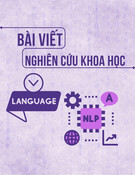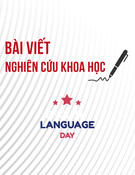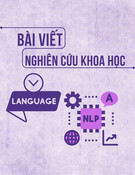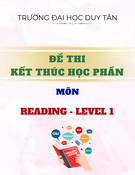
VĂN HÓA https://jst-haui.vn
Tạp chí Khoa học và Công nghệ Trường Đại học Công nghiệp Hà Nội Tập 61 - Số 2 (02/2025)
74
NGÔN NG
Ữ
P
-
ISSN 1859
-
3585
E
-
ISSN 2615
-
961
9
TEACHERS’ CODE-SWITCHING IN CLASSROOM TALK:
A CASE STUDY AT AN ENGLISH CENTER
VIỆC CHUYỂN ĐỔI NGÔN NGỮ CỦA GIÁO VIÊN TRONG GIAO TIẾP LỚP HỌC:
NGHIÊN CỨU TRƯỜNG HỢP TẠI MỘT TRUNG TÂM TIẾNG ANH
Vu Ai Linh1,*, Do Thanh Loan1
DOI: http://doi.org/10.57001/huih5804.2025.039
1. INTRODUCTION
Codeswitching, defined as
switches between two languages
in a discourse, has been discussed
with its linguistic and social
aspects. In the context of EFL
classrooms, some researchers
prioritize target language (TL)
while many others support the
interference of L1. Despite the
differences in perspectives, from
our observation, code-switching is
commonly used in the Vietnamese
context where no official language
policy in classroom interaction has
been published. Also, according to
Le, there is little research on code-
switching in Vietnamese EFL
teaching, especially studies
employing a multi-method to
gather data and analyze the
teacher use of code-switching in
Vietnamese EFL online classes [1].
For those reasons, in this paper, the
authors desire to investigate this
phenomenon with its functions in
EFL classrooms and the factors that
inspire teachers to code-switch.
2. LITERATURE REVIEW
2.1. Code-switching
The definitions of code-
switching have varied among
ABSTRACT
Using a first language (L1) in teaching English as a foreign language (EFL) has been an intriguing topic
with scholars. Accordingly, this study explores teacher codeswitching's functions in Vietnamese online EFL
classrooms for adult learners and the factor
s that motivate those switches. This study adopted a qualitative
research method with a case study approach. First, the researcher asked the participant teacher to provide
video recordings. Afterwards, data was gathered from a semi-structured interview with open-
ended
questions with the teacher participant and the teacher’s self-reflection on her practice of code-
switching
between L1 and L2 in the recorded lessons. The findings comprise the functions the teacher code-
switching
serves, including linguistic, social, and classroom-
related functions. Additionally, the findings showed that
numerous factors might lead to this phenomenon. The implications of the findings were discussed.
Keywords: Teachers’ code-switching, teaching English, functions, factors.
TÓM TẮT
Việc sử dụng ngôn ngữ thứ nhất (L1) trong bối cảnh giảng dạy tiếng Anh như một ngoại ngữ
(EFL) là
một chủ đề thu hút sự quan tâm của nhiều nhà nghiên cứu. Do đó, bài viết này báo cáo chức năng của việ
c
chuyển đổi ngôn ngữ của giáo viên trong các lớp học EFL trực tuyến ở Việt Nam dành cho người trưở
ng
thành, cũng như các yếu tố thúc đẩy việc chuyển đổi này. Nghiên cứu áp dụng phương pháp nghiên cứ
u
định tính với cách tiếp cận nghiên cứu trường hợp. Trước tiên, nhóm tác giả đã đề nghị giáo viên cung cấ
p
các video ghi hình. Sau đó, dữ liệu được thu thập từ một cuộc phỏng vấn bán cấu trúc với các câu hỏi m
ở
cùng giáo viên tham gia, và sự tự phản ánh của giáo viên về việc chuyển đổi ngôn ngữ giữ
a L1 và L2 trong
các bài giảng được ghi lại. Kết quả bao gồm các chức năng mà việc chuyển đổi ngôn ngữ của giáo viên thự
c
hiện, bao gồm các chức năng ngôn ngữ, xã hội và liên quan đến lớp học. Ngoài ra, kết quả còn cho thấ
y
nhiều yếu tố có thể dẫn đến hiện tượng chuyển đổi ngôn ngữ của giáo viên. Cuối cùng nhóm tác giả gợ
i ý
cho các nghiên cứu trong tương lai.
Từ khóa: Việc chuyển đổi ngôn ngữ của giáo viên, giảng dạy Tiếng Anh, các chức năng, các yếu tố.
1School of Languages and Tourism, Hanoi University of Industry, Vietnam
*Email: linh.vu@haui.edu.vn
Received: 25/11/2024
Revised: 18/01/2025
Accepted: 27/02/2025

P-ISSN 1859-3585 E-ISSN 2615-9619 https://jst-haui.vn LANGUAGE - CULTURE
Vol. 61 - No. 2 (Feb 2025) HaUI Journal of Science and Technology
75
researchers. Generally, it alternates between two
languages or language varieties in a discourse [2, 3].
Meanwhile, Gumperz assumed that code-switching is a
switch in a language within elements of discourse
including words, phrases, clauses, or utterances [4]. The
above perspectives are the commonly-used definition of
code-switching referring to the context of language
classrooms.
2.2. Code-switching in classroom instruction
In language teaching, methodologically, numerous
scholars and teachers call for teachers’ maximal use of the
target language (TL) in the classroom for the sake of
students’ language acquisition. Turnbull, Cajkler and
Addelman supported the idea of maximizing TL in L2
classrooms and argued that switching to L1 can lead to
the overuse of L1 in classroom instructions [5, 6]. Cook
supported the principle of maximizing the use of TL in L2
classrooms, but he also emphasized that the switches to
L1 could be employed positively in FL classes [7].
Accordingly, teachers could switch to L1 in case of
explaining vocabulary and grammar points and assigning
tasks. Cook stressed the importance of L2 as an input to
students’ language development. Le stated that the use
of the monolingual approach in the context of FL
teaching is unnatural and “unrealistic” [1]. Our study
would support Cook’s perspectives on the switch
between two languages and their functions in the
context of an EFL classroom [7].
2.3. Functions of Code-switching
2.3.1. Social functions
In the context of EFL/ESL, numerous studies have
supported the social functions of teachers’ code-
switching. According to Hoffman, teachers might employ
code-switching to socialize or express a change in
attitudes or relationships toward students [3]. Tien
pointed out that the social functions of code-switching
can be an effort to manage rapport or establish solidarity
in the classroom [8]. Also, teachers’ code-switching serves
social functions with personal talks or jokes [9].
2.3.2. Linguistic functions
Linguistically, code-switching allows interlocutors to
bridge the gap between two languages due to a lack of
linguistic proficiency [10]. For example, when unable to
find a word or expression in L2, a speaker can switch code
into L1 to transfer the message more effectively. Turnbull
examined four teachers’ use of L1 and L2, which are
English and French respectively, and found that their use
of L2 varied from 24 to 72% [5]. He assumed that teachers
who use TL less than 25% depend greatly on L1.
According to Poplack, code-switching is a linguistic norm
in a bilingual community and is a standard to evaluate
bilingual competence [2].
2.3.3. Classroom-related functions
The classroom-related functions have been subject to
a variety of classroom-based studies. Then and Ting’s
study in multilingual classrooms revealed that code-
switching served classroom-related functions including
explaining vocabulary and grammar, and managing
classes [11]. Le added that the teacher code-switched
students’ comprehension [1]. Besides, he emphasized
that the pedagogical treatment (i.e. clarifying grammar
points or word meaning) plays the key role. Those
functions of teachers’ code-switching echoed Cook’s
strategies of using L1 for FL/SL teachers [7]
2.4. Factors leading to Teachers’ code-switching
Some studies merged functions and reasons as one
aspect of code-switching while others distinguished
these aspects. In our view, a distinction between what
teachers’ code-switching does and why teachers code-
switch should be made. Our assumption is supported by
numerous studies [12-14]. According to those studies,
factors leading to code-switching are classified into
teachers’ and students’ factors.
2.4.1. Teachers’ factors
Kim and Elder examined teachers’ code-switching and
their perspectives on this phenomenon [14]. Transcript
analysis identified four factors: the teacher’s language
and educational background, teachers’ beliefs on the use
of TL, teachers’ mental or physical issues, and time
pressure of class hours. Also, Greggio and Gil admitted
that teachers code-switch to ensure students'
comprehension and Macaro added that teachers code-
switch to give instructions [12, 13]. In particular, Le added
that the teacher in his case study research code-switched
because she underestimated her students' ability to
comprehend TL or acted unintentionally [1].
2.4.2. Students’ factors
The factors coming from students seem to be
uncommon in studies. Kim and Elder stated in their
research that teachers code-switched based on
students’ poor proficiency, their emotional or health

VĂN HÓA https://jst-haui.vn
Tạp chí Khoa học và Công nghệ Trường Đại học Công nghiệp Hà Nội Tập 61 - Số 2 (02/2025)
76
NGÔN NG
Ữ
P
-
ISSN 1859
-
3585
E
-
ISSN 2615
-
961
9
conditions [14]. Greggio and Gil added that teachers
code-switched to reduce students’ stress and anxiety in
certain situations [13].
To summarize, the literature review discussed the
phenomenon of code-switching. Teachers’ code-
switching, commonly defined as the alternate use
between L1 and TL in the same discourse, serves different
functions (i.e. social, linguistic, and classroom-related
functions) and two main factors are motivating this
practice in EFL classrooms.
The literature review in classroom-based settings
identified several limitations. First, as mentioned, few
studies on teachers’ code-switching were conducted in
the Vietnamese EFL teaching context, especially in online
English classes. Second, most research on teachers’ code-
switching assimilated reasons for teachers’ code-
switching with its functions; also, they mainly focused on
the classroom-related functions of this phenomenon.
This study aims to investigate the functions of the
teacher's code-switching and the factors leading to her
practice of code-switching in the context of Vietnamese
online EFL classes with the following questions:
1. What are the functions of the teacher's code-
switching in this context?
2. What are the factors leading to teacher's code-
switching?
2.5. Methodology
This study employs qualitative research with a case
study approach adopted from Yin [15]. The authors chose
this method to study “an issue explored through one or
more cases within a bounded system” to gain in-depth
knowledge of a teacher’s code-switching as a
phenomenon in ESL/EFL classrooms [16].
2.5.1. Participants and contexts
This paper explores the practice of code-switching by
a single teacher with nine years of teaching experience,
including three years of experience teaching online
classes. The authors recruit the participant teacher by
purposive sampling based on appropriate sections of the
population [17].
The study is conducted in a private institution in Hanoi
where English is taught through Zoom, an online
platform. The course was designed for pre-intermediate
adult learners who study English for specific purposes.
The curriculum was adopted and adapted from the
coursebook Market Leader published by Pearson.
2.5.2. Data collection and management
In this study, triangulation, referring to the use of
multiple methods of collecting data in a human
behavior study, will be employed to ensure credibility
[15, 16]. First, class recordings, used to increase the
study's trustworthiness [15] are used to get information
on the functions of code-switching. Afterwards, a semi-
structured interview which involves a set of questions
was chosen to get in-depth knowledge of a teacher’s
code-switching. With pursuing and probing techniques,
this data collection method allows the interviewer to get
new themes from the data set [17], and clarify some
points in case the class recording transcriptions are
unclear.
To pilot the interview guide, the authors employ three
steps: internal testing, expert assessment, and field testing,
as Kallio et al. proposed [17]. However, to avoid any
potential changes in participant’s behavior in classrooms,
we follow the first two steps. First, the data collected goes
through a preliminary data analysis. The authors
transcribed what was said in class and the interview
recording without any predetermined focus [18]. The
authors also send transcripts to the teacher and ask her to
correct any misinterpretations. Afterwards, the authors
conducted the thematic analysis with a data-driven
approach proposed by Boyatzis with three steps, including
deciding on sampling and issues, generating themes and
codes, and validating and using codes [18]. Also, the class
recordings will be examined and reflected by the teacher
to get the teacher’s insights into her switches.
3. RESULTS AND DISCUSSION
Based on class video recordings, teacher reflections,
and interviews, this part presents the functions that
teachers’ code-switching served and factors that
encouraged the teachers to code-switch in their English
classrooms from the teacher’s perspectives, followed by
a discussion of those findings.
3.1. Functions of codeswitching
3.1.1. Linguistic functions
Transcribing class recordings also identified a
linguistic function the teacher’s codeswitching served.
Extract 1:
T… tức là mọi người phải deal với nhau và chị phải
thuyết phục được chị Lan Anh bởi vì chị Lan Anh yêu cầu
chỉ có 3 đô thôi…

P-ISSN 1859-3585 E-ISSN 2615-9619 https://jst-haui.vn LANGUAGE - CULTURE
Vol. 61 - No. 2 (Feb 2025) HaUI Journal of Science and Technology
77
<It means that you have to deal with each other, and you
must convince Miss Lan Anh because Miss Lan Anh wants it
with 3 dollars>
The teacher code-switched the above extract with the
word “deal”. In the reflection, she wrote: “‘Deal’ is a
common word in Vietnam even when we have
conversations in our mother language, so I just used it as
a habitual action”. This finding supports the linguistic
functions of codeswitching in Merrit et al.’s study [10].
3.1.2. Social functions
The data revealed that the teacher’s practice of code-
switching also facilitates the social aspect of classroom
interaction. In the present study, the teacher code-
switched to manage rapport with her students. Her effort
to establish rapport with students included encouraging
students, praising their performance, and joking.
The following extract identified the teacher’s effort in
encouraging students to perform an oral task
Extract 2:
T All right nhìn chung là mình đặt câu hỏi như thế này
cũng khá là thành công rồi có mất mỗi cái câu này thôi
được chưa ạ but I can understand
<All right, in general, you succeeded in making
questions, except for this question, but I can understand>
In the above extract, after commenting on their
performance, the teacher switched between English and
Vietnamese. In her reflection, the teacher admitted that
she had corrected numerous errors before that turn, so
she switched to English to confirm her intelligibility
despite her students' mistakes. This practice, from her
perspective, encouraged her students to use the target
language with a lower level of anxiety.
Also, she code-switched to give compliments.
Extract 3:
S climbing
T Đúng rồi hay rồi đấy ạ rockclimbing
<Yes, that was great, rock climbing>
In the extract above, the teacher appraised students in
Vietnamese “đúng rồi hay rồi đấy ạ”, then switched to
English by reading the word "rock climbing" again to
confirm her compliment to students’ correct
pronunciation.
Joking, in the form of switches between L1 and L2, was
recruited to manage rapport in classroom interaction.
Extract 4:
T Vậy giờ chị đi lại đi nhiều thứ mới lắm. Local food
phải đi với local people đúng không chị thì mình mới biết
được nhiều quán ngon chứ xem trên mạng sợ là cũng
không được
<Now you should go back there, go with local people to
try local food right, local people know good restaurants
while reviews on the Internet are not reliable>
When students argued about restaurants in Da Nang,
the teacher, as the teacher self-reflected, switched back
and forth to make the conversation less serious. The
social functions of those switches aimed to make
students more comfortable and establish solidarity in
classroom interactions [8], and thus, students might
become more engaged in the lessons [20].
3.1.3. Class-related functions
a) Teaching content
While teaching vocabulary, the teacher explained the
vocabulary, and spelling by translating or asking students
to translate the target words into either Vietnamese or
English. The extracts below illustrated the teacher’s
practice of codeswitching when she explained
vocabulary.
Extract 5:
T Rock climbing Climbing rock Rock Rock là gì ạ
S là nhảy à
T No mình có từ climb là leo trèo vậy tìm cho em ạ
rock climbing
Đúng rồi vậy nó là gì ạ rock climbing là leo gì ạ
S leo núi
First, the teacher mentioned the word presented on
the slide and then asked students what it meant.
Afterwards, she separated the word “rock climbing” to
check if students understood each component of the
word and activated students’ prior knowledge of each
word (rock and climbing) to understand the whole word.
Meanwhile, she switched back and forth to Vietnamese to
explain the vocabulary.
In addition to vocabulary, Vietnamese was employed
as a tool used to clarify the English pronunciation.
Extract 6:
T buffet buffet cái âm et này hay được đọc là ei lắm
ví dụ mình có ballet nó cũng viết như này ballet đúng
không ạ đó cũng là ei luôn hoặc là chăn bông đúng không

VĂN HÓA https://jst-haui.vn
Tạp chí Khoa học và Công nghệ Trường Đại học Công nghiệp Hà Nội Tập 61 - Số 2 (02/2025)
78
NGÔN NG
Ữ
P
-
ISSN 1859
-
3585
E
-
ISSN 2615
-
961
9
ạ duvet đó buffet ballet duvet ok đó tất cả et đều đọc là
ei thường viết như này mọi người hay đọc là ballet hay
buffet gì đó mình đọc là buffet ballet duvet so be careful
with that
In the example above, the teacher corrected students’
pronunciation of the word “buffet” after the speaking
session in the form of delayed feedback. First, she
modeled the pronunciation of “buffet” by saying “cái âm
et này hay được đọc là ei lắm” (“et” is usually pronounced
as [ei]), then switched into Vietnamese to facilitate
students with the pronunciation of “buffet” ".
Simultaneously, she switched back to English to
introduce some words with similar pronunciation, i.e.
ballet, duvet “buffet ballet duvet ok”, then summarized
“đó tất cả et đều đọc là ei thường viết như này mọi người
hay đọc là ballet hay buffet gì đó mình đọc là buffet ballet
duvet” (so all “et” that you pronounced as [ˈbʌf.et] [bal.et]
[duv.et] should be [bəˈfeɪ] [bælˈeɪ] [duːˈveɪ]).
In the following extract, the teacher code-switched to
compare the pronunciation between two languages.
Extract 7:
T lại cho em nào rock chứ không phải rốc nhé rock
nhạc rock ấy đúng không ạ rock rockclimbing
<one more time rock not roc rock rock music right rock
rock climbing>
S rockclimbing
T âm b bị câm nha bỏ qua chữ b cho em climbing
climbing
<b is silent skip it climbing climbing>
After the pronunciation drill for students, the teacher
found some students mispronounced the word “rock
climbing”, so she switched to Vietnamese to clarify the
differences between pronouncing ‘rốc’, a Vietnamese
word, and “rock”, and explain how to read the word
“climbing” correctly.
The instructor code-switched to L1, Vietnamese while
giving lectures that included explanations of English
grammar points. Normally, the teacher starts with the
concepts of grammar in English, and then explains the
rules and how to apply those concepts in Vietnamese, as
shown in the following examples:
Extract 8:
T mọi người có nhớ từ too và enough không ạ too
nghĩa là gì ạ
S quá
T nếu đã là quá thì từ này có nghĩa tốt hay không tốt
ạ positive or negative chỉ có tốt và không tốt chứ không
có không tốt lắm nha okay negative luôn ạ cái gì quá thì
cũng không tốt còn enough thì có nghĩa là đủ nha thì nó
là tốt nhưng giờ mình dùng là isn’t enough thì lại là không
tốt ngay đúng không ạ còn từ too thì nó luôn là negative
rồi được chưa ạ
In the above extract, the majority of the explanations
are in English but sometimes she switched back and forth
“mọi người có nhớ từ too và enough không ạ too nghĩa là
gì ạ” (do you remember what “too” and “enough”
means?). Similarly, she said “nếu đã là quá thì từ này có
nghĩa tốt hay không tốt ạ positive or negative” (if it means
“too much”, is it good or not, positive or negative?), and
“enough thì có nghĩa là đủ nha thì nó là tốt nhưng giờ
mình dùng là isn’t enough thì lại là không tốt ngay đúng
không ạ còn từ too thì nó luôn là negative rồi được chưa
ạ” (“enough” means “we have enough”, it is good but if
we say “isn’t good enough”, it is negative. Meanwhile,
“too” is always negative, okay?).
The teacher tends to employ code-switching as a
strategy to explain new concepts, terms, and grammar
points, and this finding might lend support to Bhatti et
al.’s and Lee’s findings on this phenomenon [21, 22]. Also,
Mochacha and Lwangale assumed that the proper use of
L1 in teaching vocabulary and grammar facilitates
students’ L2 development [23].
b) Giving instruction
Teachers’ instruction management refers to how they
give and manage instructions during lessons. The
following extract presented the teacher’s practice of
codeswitching in a variety of activities to manage her
instructions including explaining and exemplifying
instructions.
Extract 9:
T OK So that's good for the first time just yes and
then answer the question But for the second time I want
you to give more information for each answer OK Cái
phần này thì chị Lan Anh làm trước nha tức là lần tiếp theo
này chị Phụng hỏi và chị Lan Anh trả lời. Ví dụ chị Phụng
hỏi International School tức là chỉ có 1 cái đúng không ạ
đây It’s Toronto School chẳng hạn and it’s for both
Vietnamese students and foreigners to study there và
thêm thông tin it’s in the center of the city for example
tức là mình phải cung cấp thêm thông tin chứ không phải
chỉ mỗi yes hoặc no. Get the point. Đúng cho em nhé ví















![Đề cương môn Tiếng Anh 1 [Chuẩn Nhất/Mới Nhất]](https://cdn.tailieu.vn/images/document/thumbnail/2025/20251130/cubabep141@gmail.com/135x160/51711764555685.jpg)










